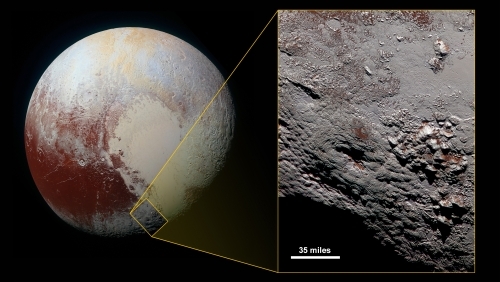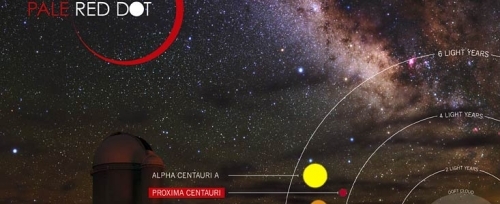Paul Gilster's Blog, page 160
January 27, 2016
KIC 8462852: No Dimming After All?
As if the Kepler star KIC 8462852 weren’t interesting enough, Bradley Schaefer (Louisiana State) added to the controversy when he discovered what appeared to be a steady dimming of the star over the past century. Schaefer called the result “completely unprecedented for any F-type main sequence star,” and given the discussion about KIC 8462852 as a SETI target, this raised the stakes. Something just as odd as the object’s strange lightcurves was going on here, and it seemed natural to think that the dimming and the lightcurves were related.
But Michael Hippke now begs to disagree. An old friend of Centauri Dreams (see, for example, his Exomoons: A Data Search for the Orbital Sampling Effect and the Scatter Peak), Hippke takes a close look at Schaefer’s work and reaches a different conclusion. As he sees it, the ‘dimming’ of up 0.165 ± 0.013 magnitudes per century in this F3 star may actually be the result of imperfect calibration on the Harvard plates. In other words, while the lightcurve anomalies remain, the dimming may well be a data artifact rather than an astrophysical enigma.
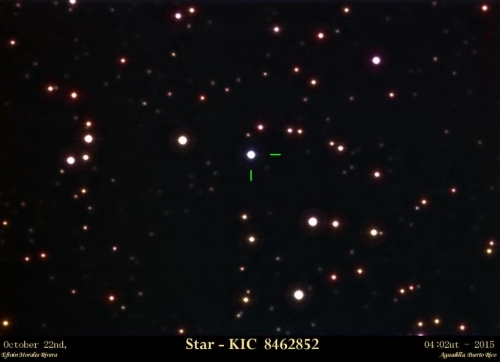
Image: KIC 8462852 as photographed from Aguadilla, Puerto Rico by Efraín Morales, of the Astronomical Society of the Caribbean (SAC).
First, though, a word about Bradley Schaefer’s work, about which Hippke says “Schaefer had the excellent idea to look into the old plate archives. To solve this mystery, we need all the information we can get, and Schaefer did very careful and high-quality work.”
This parallels comments I’ve heard from other professionals, who praise the quality of Schaefer’s analysis. Submitted to Astrophysical Journal Letters, the Hippke paper looks to contrast the ‘dimming’ of KIC 8462852 with an analysis of other F-type main sequence stars from the same dataset. Along the way, Hippke double-checks Schaefer and finds sound work:
Although the process of data cleansing and binning involves arbitrary choices, we have reproduced this part of the analysis for all variants with virtually identical results. It is therefore important to note that the method and results in Schaefer (2016) appear to be adequately careful and accurate. In the following, we will thus concentrate solely on the interpretation of his result – whether the dimming is “unprecedented”.
Take away its odd lightcurves and KIC 8462852 appears to be a relatively normal star. Thus Hippke’s criteria for study are F-stars from the Kepler field of view, from which photometry is studied for the 3 most quiet F-dwarfs and 25 bright F-dwarfs in the Harvard DASCH (Digital Access to a Sky Century @Harvard) archive. Trends in the data may not, Hippke believes, be slow drifts but ‘structural breaks’ — in other words, changes caused by abrupt changes in technology or calibration techniques. Evidence for this occurs not only for KIC 8462852 but also for KIC 7180968, indicating we are dealing with a phenomenon not isolated to KIC 8462852.
From the paper:
The significant trends (and/or structural breaks) found in 18 of 28 comparison stars support the interpretation that the dimming of KIC 8462852 is not extraordinary. A careful analysis of each dataset is time-consuming, which is why we have not performed this analysis for hundreds of stars. In case of further doubt on the significance of such trends, the analysis presented could simply be expanded to more stars.
This would make an astrophysical interpretation of the ‘dimming’ unlikely because it would require that a number of main-sequence F-dwarfs fluctuate by 10% or more over the course of a century. “It seems more likely,” writes Hippke, “that the change of emulsions, errors in calibration etc. cause these trends.” In an email just received, Hippke notes of Schaefer’s work that “It might just be that his check stars were unusually stable, which obfuscated existing trends in the data.”
Thus the paper favors the notion that changes in technology and imperfect calibration — quality issues in the dataset itself — explain what otherwise appears to be long-term dimming of KIC 8462852. This leaves us, as the author notes, with the short-term dimmings found in KIC 8462852’s lightcurves, a problem that the question of century-long dimming does not address.
What can be done to investigate the dimming issue further? Hippke’s email suggests that other data, particularly plates from the Sonneberg Observatory in Germany, will be useful for comparison. “Unfortunately, these plates are not available online and have only partially been scanned, so checking these data might take several months.”
The paper is Hippke, “KIC 8462852 did likely not fade during the last 100 years,” submitted to the Astrophysical Journal Letters (preprint).






In Search of the First Rocket Man
If you’re interested enough in space to be reading this site, you’ve probably run into the name of Wan Hu. He’s the subject of a tale that may well be spurious, but it’s certainly lively. It seems that some time around the year 1500 AD, Wan Hu took his fascination with rocketry to the logical limit by building a chair equipped with 47 gunpowder rockets. Lit by 47 attendants, the combined rockets took Wan Hu somewhere, but just where is unknown, as he is said to have disappeared with a loud bang, leaving only a pall of smoke hanging over the scene.

The first rocket man? Maybe. But experts on science in China find it more likely that the tale was invented somewhere in Europe, during a period (17th-19th century) when Chinese motifs were much in vogue. Frank Winter (National Air and Space Museum, Washington DC) did his own investigation and could find no mention of Wan Hu in Ming Dynasty biographical guides or histories. And apparently there are variants involving not Wan Hu but ‘Wang Tu,’ who is said to have lived 2000 years ago. This story popped up in a 1909 issue of Scientific American and involves the same rocket chair, but Wang Tu manages to survive.
Image: The fabulous Wan Hu. Who knows where he wound up? Credit: National Air & Space Museum, Smithsonian Institution, Washington DC.
I have all this from a wonderful 1992 paper that Winter wrote for the Journal of the British Interplanetary Society, sent to me by my friend Al Jackson. Al was wondering about a fellow named Frederick Rodman Law, who like Wan Fu was obsessed with rockets. I had never heard of Law either, but in Winter’s view, in Law we have the first proven occurrence of pre-Space Age manned rocket flight, an event that took place in 1913. Known as ‘the human bullet’ and other professional names, Law was a showman and Hollywood stunt man whose sister was flyer Ruth Law.
Law’s plan (according to the New York Times: To blast off from Jersey City, NJ and land in Elizabeth, about nineteen kilometers away (Winter thinks the rocket would actually have landed either back in Jersey City or in Newark if it had worked). Law’s rocket was 14 meters tall, ending in a conical steel cap with an opening for Law to crawl into. 408 kg of gunpowder provided the punch, evidently supplied by the International Fireworks Co. Law intended to ride the rocket up to about 1000 meters and then jump out so as to parachute to Earth.

Winter draws on the New York Times account of what happened:
A crowd of about 150 people gathered that morning to see Law off. His rocket was set “on a mound of earth surrounded by marsh and rushes.” Continued the Times: “A motion picture operator became active when Law himself appeared, clad in khaki [if it still exists, this film has never been found]… When all the preliminary scenes had been duly recorded Law mounted a scaffold which had been built besides the rocket to enable him to reach his seat, which was about 18 feet (5.4m) above the ground. “You may light the fuse when ready, Sam (Samuel L. Serpico, Manager of the International Fireworks Co.), announced Law after he had taken the seat.
“The motion picture man rapidly placed a high-power lens on his machine to follow the shaft to Elizabeth… The spark climbed up several feet of fuse, sputtering menacingly… After a few seconds there was a terrific explosion with a shock that threw most of the crowd to the ground [as] the big projectile burst into a thousand pieces…
Image: Frederick Rodman Law atop his vehicle. Credit: National Air & Space Museum, Smithsonian Institution, Washington DC.
The amazing thing is that, unlike Wan Fu, Law did not join his ancestors at this point. He was thrown about nine meters from the rocket, and a physician in the crowd discovered that the only thing wrong with him was scorching to his hands and face, although his clothes were a mess. Law would go on to perform such feats as climbing the US Capitol dome (the police stopped the stunt), and dropping from an exploding balloon, exploding craft evidently being his trademark. When he did eventually die in 1919, it was quietly, of tuberculosis, in South Carolina.
Winter’s paper is worth checking out if you’re near a library with JBIS available. He goes into various tales worldwide, such as that of Lagari Hasan Çelebi, who was said to have flown a gunpowder rocket to altitude in the 17th Century and then coasted down after deploying ‘wings’ on the device to land. Like Wan Hu, the tale has never been corroborated. We also have stories like that of Claude-Fortuné Ruggieri, a doughty pyrotechnist who somewhere around 1830 constructed a rocket that was to launch a man from the Champ de Mars in Paris. This attempt was fairly well along, but when the volunteer pilot turned out to be a small boy, the police stepped in and banned the flight. Ruggieri’s tale, too, is hard to corroborate.
Perhaps the strangest of the many tales in Winter’s paper is his account of a ‘Signor Camarara,’ presented as an attraction at the 1901 Pan-American Exposition in Buffalo, NY. Said to be a ‘human skyrocket,’ Camarara was said in a newspaper account to have previously flown a rocket near the turn of the century in Callao, Peru. The vehicle was said to have had four exhausts, all of which used a strange, secret fuel Camarara called ‘dynoascenemite.’ Blasting off, Camarara was lofted to almost 5000 meters before landing safely by parachute.
Winter, as you would imagine, will have none of this one, pointing out that even Robert H. Goddard had trouble reaching altitudes like this with much more efficient liquid-fueled rockets decades later. Like other rocket man tales Winter has collected, Camarara’s story was surely a hoax, speaking to the power rockets held over daredevils and cranks early in their development, as well as to the gullibility of those willing to believe such astounding stories.
But we have to give Frederick Rodman Law credit. He had plenty of witnesses, was well advertised, and had the guts to climb into a gunpowder-fueled rocket with the cameras rolling. Good for Frank Winter for telling his tale. Just ahead were the Opel-RAK rocket vehicles, including the Opel RAK.1, a rocket glider flown in 1929 in Germany, and the various rocket-powered aircraft developed by Allied and Axis powers during World War II, the most famous being the Me-163 and the suicidal Japanese Yokosuka MXY-7 Ohka. The story of the rocket was quickly going from tall tale and stunt to scientific fact.
The paper is Winter, “Who First Flew in a Rocket?” Journal of the British Interplanetary Society Vol. 45 (1992), pp. 275-280.






January 26, 2016
Planet in Widest Orbit Yet Discovered
Free floating planets — planets without any star — are exotic things, presumably thrown out of their original solar system by gravitational interactions with other worlds. But the line between such wanderers and bound planets isn’t always clear. A case in point is the object 2MASS J2126, found in an infrared sky survey and at one point considered to be part of a group of young stars known as the Tucana Horologium Association. If linked to this group, its age could be inferred and it was young and low enough in mass to be considered an independent planet.
Now we learn otherwise, as a research team from the United Kingdom, Australia and the United States has determined that 2MASS J2126 is in an extraordinarily wide orbit around the star TYC 9486-927-1. Lead author Niall Deacon (University of Hertfordshire) has been focusing for several years on young stars with planetary companions in wide orbits. But this system has to come as a surprise. The young planet is about 1 trillion kilometers from the star, a whopping 7000 AU. By way of comparison, 2,000–20,000 AU is thought to be the extent of the inner Oort Cloud (also called the Hills cloud) in our system. Proxima Centauri is roughly 15000 AU from Centauri A and B, little more than twice the distance of 2MASS J2126 from its star.
In this work we present the identification of two previously known young objects in the solar neighbourhood, TYC 9486-927-1 and 2MASS J21265040-8140283, as a co-moving wide pair with a probable planetary mass secondary. During an examination of the literature we found that these two objects are separated by 217″ and have similar proper motions. Hence we attempted to better determine their properties to see if they were a likely young, bound system. Using revised astrometry and detailed kinematic analyses of nearby young stars and brown dwarfs, we have determined that this previously known young brown dwarf/free-floating planetary mass object and young low mass star are a likely widely separated bound pair.
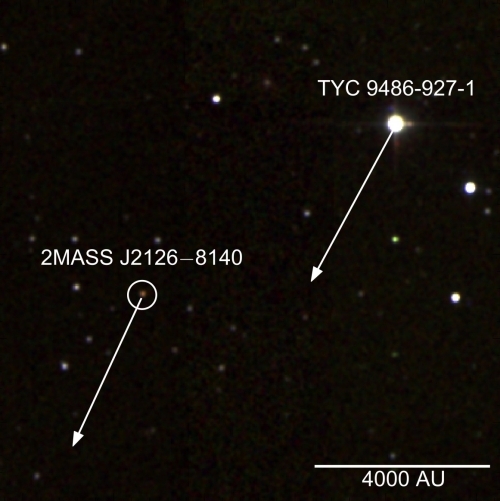
Image: False colour infrared image of TYC 9486-927-1 and 2MASS J2126. The arrows show the projected movement of the star and planet on the sky over 1000 years. The scale indicates a distance of 4000 Astronomical Units (AU), where 1 AU is the average distance between the Earth and the Sun. Credit: 2MASS/S. Murphy/ANU.
Planets in very wide orbits are scarce (the paper calls them ‘a currently small but previously unexpected population of massive gas giant companions to stars’), but we do have four others: WD 0806-661B (2500 AU); GU Psc b (2000 AU); SR12 C (1100 AU); and Ross 458 C (1160 AU). All four of these objects were discovered through direct imaging. Just over 100 light years from Earth, 2MASS J2126 can now lay claim to the widest orbit of any planet found around another star, with each revolution taking some 900,000 years to complete.
“This is the widest planet system found so far and both the members of it have been known for eight years,” said Dr Deacon, “but nobody had made the link between the objects before. The planet is not quite as lonely as we first thought, but it’s certainly in a very long distance relationship.”
As mentioned above, the earlier presumed connection with the Tucana Horologium Association offered a way of establishing the age of the star. But without being able to confirm that connection, Deacon and team studied the parent star’s spectrum, finding that TYC 9486-927-1 shows a stronger signature for lithium that would be expected in 45 million year old stars. Lithium is destroyed early in a star’s life, so the lithium signature can be a valuable marker. The star’s lithium signature is also weaker than ten million year old stars, making the probable age somewhere between the two figures. The paper compares the star to different stellar moving groups (remnants of a stellar association still moving roughly together):
It is clear that the TYC 9486-927-1 has stronger lithium absorption than stars of similar spectral type in TucHor [Tucana Horologium], weaker absorption than TWA [TW Hydrae] members but in reasonable agreement with β Pic [Beta Pictoris] members. Based on this comparison we conclude that TYC 9486-927-1 is older than TWA and likely of similar age or younger than TucHor. Thus, our Li analysis suggests an age comparable to the β Pic moving group, but we note that Li depletion in low-mass stars can be affected by initial conditions (rotation, episodic accretion) and we therefore adopt a conservative age range of 10–45 Myr.
With these age estimates in mind, the team went on to estimate the mass of the planet, which turns out to be on the boundary between planets and brown dwarfs — 11.6 to 15 times the mass of Jupiter. The closest analogue we have to 2MASS J2126, then, is the planet β Pictoris b, although the former is more than 700 times further from its host star. How a planet in such a wide orbit forms in such a system should be interesting fodder for future work.
The paper is Deacon et al., “A nearby young M dwarf with a wide, possibly planetary-mass companion,” in press at Monthly Notices of the Royal Astronomical Society (abstract). An RAS news release is also available.






January 25, 2016
Proxima Centauri & the Imagination
My essay Intensifying the Proxima Centauri Planet Hunt is now available on the European Southern Observatory’s Pale Red Dot site. My intent was to give background on earlier searches for planets around the nearest star, leading up to today’s efforts, which include the Pale Red Dot work using HARPS, the High Accuracy Radial velocity Planet Searcher spectrograph at La Silla, as well as David Kipping’s ongoing transit searches with data from the Canadian MOST satellite (Microvariability & Oscillations of STars), and gravitational microlensing studies by Kailash Sahu (Space Telescope Science Institute).
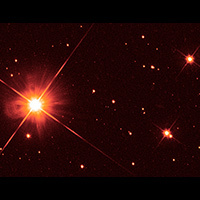
As it turned out, the choice of earlier Proxima planet hunts as a topic fit in where Alan Boss had left off. Boss (Carnegie Institution for Science) had led off the Pale Red Dot campaign’s outreach effort with a piece on the overall background of exoplanetology (Pale Blue Dot, Pale Red Dot, Pale Green Dot). Whatever the color of the distant world, our tools are developing rapidly, and there is a heady sense of optimism that we have what we need to find Proxima planets, assuming they are there. As Boss puts it:
We now know that nearly every star we can see in the night sky has at least one planet, and that a goodly fraction of those are likely to be rocky worlds orbiting close enough to their suns to be warm and perhaps inhabitable. The search for a habitable world around Proxima Centauri is the natural outgrowth of the explosion in knowledge about exoplanets that human beings have achieved in just the last two decades of the million-odd years of our existence as a unique species on Earth. If Pale Red Dots are in orbit around Proxima, we are confident we will find them, whether they are habitable or not.
Image: Proxima Centauri (Alpha Centauri C). Credit: NASA, ESA, K. Sahu and J. Anderson (STScI), H. Bond (STScI and Pennsylvania State University), M. Dominik (University of St. Andrews).
Saturday was cloudy, but Sunday offered up a fourth HARPS observation window, activity you can follow on Twitter @PaleRedDot. Let me also remind you that David Kipping wrote up the MOST work just prior to its inception in 2014 (see Proxima Centauri Transit Search to Begin). The latest I have from Dr. Kipping is that 13 days of data in that year were followed by another 30 in 2015. We should have results by the summer of this year. As to gravitational microlensing, we have a second occultation of a background star by Proxima coming up in February. Hope grows that we are getting close to a detection by one method or another.
and after losing a data-point on Saturday(clouds :S), we got a fourth HARPS obs today…yey! building up baseline https://t.co/BsC9M2fKNL
— Pale Red Dot (@Pale_red_dot) January 25, 2016
Proxima Centauri’s Emergence in Fiction
I’ve always been surprised that there wasn’t a greater flurry of interest in Proxima Centauri in early science fiction, given that the closest star to the Sun had just been discovered in 1915. Still, a few odd tales emerged, among the more interesting being Henri Duvernois’ L’homme qui s’est retrouvé (1936), which the indispensable Brian Stableford translated in 2010 as The Man Who Found Himself. Here we have a scientific romance in the grand style, with the journey to Proxima Centauri meshing with time travel and an encounter with the protagonist’s doppelgänger. Stableford has done wonders in reawakening interest in French scientific romance; his labors as translator and critic receive all too little credit.
And then there’s Murray Leinster (Will F. Jenkins), whose story “Proxima Centauri” ran in Astounding Stories in March of 1935. Leinster wanted to treat a journey to another star within a different context. Rather than presenting a dream-like moral tale, he showed a starship (the Adastra) that was capable of getting his characters to Proxima well within a human lifetime. The description is heavy on theatrics, minimal on detail, but it’s fascinating to see writers beginning to consider the sociological problems of long voyages. The Adastra will take ten years to reach its destination, and the crew will deal with mutinies, angst and utter boredom as the price of their ticket.
It’s interesting to see science fiction grappling with how to imagine starflight in this era. Coming out of the age of Gernsback, Leinster wanted solutions more satisfying to the science experimenter of the day than simply ignoring what physics was telling us about time and space. But how to do it? The results demanded giving up one kind of magic (faster than light methods) in favor of another, an authorial sleight of hand that tries to slip one over on the reader. Thus we read about the starship Adastra’s “tenuous purple flames,” which were actually “disintegration blasts from the rockets” which had lifted the craft into space, and so on.
Anyone who digs up Leinster’s “Proxima Centauri” today will find that despite its reputation in its own time, it hasn’t aged well, and the interest of the effort will be purely an antiquarian one. But we do see the emergence of a greater appreciation of interstellar distances and the problems of staying within known physics in Leinster’s story (available in Asimov’s Before the Golden Age (Doubleday, 1974). Such efforts stand in stark contrast to anemic tales like Frederick Hester’s “Gipsies of Thos,” (Amazing Stories, May 1935) or Leslie Stone’s “Across the Void” (Amazing Stories April-June 1931), both tales that take us to the Centauri stars as if by magic carpet.
Today’s science fiction gives us a Proxima Centauri of considerably more detail, along with a more realistic assessment of the propulsion conundrum that accompanies the voyage. With that detail we’re also given further mysteries about which to speculate. Here’s Stephen Baxter describing the Proxima planet Per Ardua in his novel Proxima (Roc, 2014):
The weather was overcast, muggy, humid. For such a static world the weather had turned out to be surprisingly changeable, with systems of low or high pressure bubbling up endlessly from the south. It was warm in this unending season, always like a humid summer’s day in North Britain, from what Yuri remembered of the weather. But the ColU, ever curious in its methodical robot way, said it had seen traces of cold: frost-shattered rock, gravel beds, even glaciated valleys in the flanks of features like the Cowpat. Evidence that glaciers had come this way in the past, if not whole ice ages. Somehow this world could deliver up a winter.
It’s a winter caused not by axial tilt but by massive eruptions of starspots on Proxima’s face, driving weather patterns on the kind of tidally locked habitable world we may one day find through our ongoing planet hunts. If and when we do find the ‘pale red dot’ around Proxima, writers will continue imagining it, always tightening the detail as new facts emerge, until one day, we can hope, we have robotic or even human emissaries reporting back from the scene.






January 22, 2016
A New Filter for Life’s Survival
How do we make out the odds on our survival as a species? Philosopher Nick Bostrom (University of Oxford) ponders questions of human extinction in terms of a so-called Great Filter. It’s one that gives us a certain insight into the workings of the universe, in Bostrom’s view, because it seems to keep the galaxy from being positively filled with civilizations. Somewhere along the road between inert matter and transcendent intelligence would be a filter that screens out the vast majority of life-forms, keeping the population of the galaxy low, and offering us a way to gauge our own chances for survival.
Think of it this way. Perhaps the Great Filter has to do with the formation of life itself. If that is the case, then we have already made it through the filter and can go about exploring the universe. But if the Great Filter is in our future, then we can’t know exactly what it will be, and neither can we know whether we will survive it. Here the final term in Frank Drake’s equation comes to mind, the one specifying the lifespan of technological civilizations. Perhaps the Great Filter has to do with technology destroying itself. In that case, the filter could spell our doom. For more on Bostrom’s ideas, see Bostrom: From Extinction to Transcendence.
Through the Gaian Bottleneck
An ominous view, some would say, but along come Aditya Chopra and Charles Lineweaver (Australian National University), with a new paper suggesting a different kind of filter. The authors call it the Gaian Bottleneck, and it’s a filter that life on Earth has already passed through. The scenario is that life is fragile enough that it rarely develops into intelligence.
The reason: Young planetary environments are unstable. The life that does emerge needs to find ways to regulate greenhouse gases like water and carbon to keep surface temperatures in the habitable range. Normally we think of the decrease in the incoming bombardment of Solar System debris going back 4.5 billion years and extending to about 3.8 Gya as being a key to making the Earth more suitable for life, but the Gaian Bottleneck sees early life as being under strong selection pressure to modify and regulate its own environment. From the paper:
… bombardment rates inevitably decrease in the circumstellar habitable zones (CHZs) of stars, but the timescales for the evolution of Gaian regulation are probably unpredictable and would not inevitably evolve rapidly (or at all). Thus, if there is anything special about what happened on Earth to allow life to persist here, it might have less to do with the decreasing bombardment rate in the Hadean, or special chemical ingredients, or sources of free energy, or even a rare recipe for the emergence of life. The existence of life on Earth today might have more to do with the unusually rapid biological evolution of effective niche construction and Gaian regulation in the first billion years. Habitability and habitable zones would then not only be a passive abiotic property of stellar and planetary physics and chemistry (such as stellar luminosity, initial water content, and decreasing bombardment rate) but would also be a result of early life’s ability to influence initially abiotic geochemical cycles and turn them into the life-mediated biogeochemical cycles that we are familiar with on the current Earth…
In this view, we have gotten through the filter already, finding ourselves in a position not shared by planets around us. Conceivably, both Mars and Venus were once habitable, but a billion years after formation, Venus turns into the hell it is today and Mars goes into a deep freeze. Chopra and Lineweaver argue that if there was early microbial life on either world, it was unable to stabilize its environment, whereas on Earth, life played an active role in doing just that.
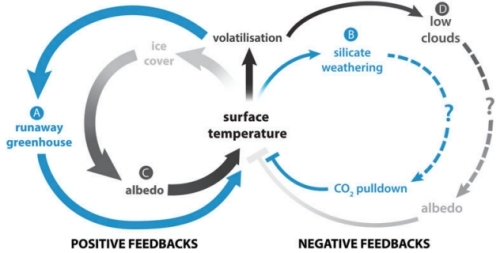
Image: Early Abiotic Feedbacks. During the first billion years after the formation of Earth (or of Earth-like planets), abiotic positive feedbacks (left) can lead to runaway surface temperatures outside the habitable range (both too hot and too cold). These positive feedbacks lead to the loss of liquid water [either from hydrogen escape to space or condensation into ice. Abiotic negative feedbacks (right) have been invoked to stabilize surface temperatures, but they may not be significant in the first billion years, hence the dashed lines and the question marks. As life evolves, it can strengthen or weaken these initially abiotic geochemical feedback loops and turn them into biogeochemical cycles and feedback loops. Evolving life can insert itself into these feedbacks at the points labeled A, B, C, and D. Credit: Aditya Chopra and Charles Lineweaver/ANU.
We can thus look without surprise on a galaxy where rocky terrestrial-class worlds are common even while life itself is not. Early extinction becomes a near universal phenomenon:
We argue that the habitable surface environments of rocky planets usually become uninhabitable due to abiotic runaway positive feedback mechanisms involving surface temperature, albedo, and the loss of atmospheric volatiles. Because of the strength, rapidity, and universality of abiotic positive feedbacks in the atmospheres of rocky planets in traditional CHZs, biotic negative feedback or Gaian regulation may be necessary to maintain habitability.
What, then, do we find on the planets of nearby stars? Not ancient ruins of advanced civilizations that have long ago destroyed themselves, but the fossilized remnants of extinct microbial life. No shattered remains of cities but long-gone remnants of simple life that failed in its mission to make its own planet a place where more complicated forms could develop. We would be living in a universe where almost all life is young, microbial, or extinct.
Chopra and Lineweaver run through a variety of ways their argument could be challenged. If Gaian regulation, for example, is a key to making a young planet into a place where life can survive, why should it necessarily be rare? Moreover, Gaian regulation is usually considered as starting in the Proterozoic, around 2.5 Gya. Invoking a pre-Proterozoic Gaia is even more controversial, to say the least. And the paper notes that abiotic negative feedback on the carbonate-silicate cycle could have stabilized surface temperatures on Earth without any recourse to Gaian regulation. Other potential objections are also weighed.
But knowing how many imponderables they are dealing with, the authors nonetheless suggest this sequence of events, which they consider ‘potentially universal,’ on young, wet planets:
First *0.5 Gyr: Hot, high bombardment, uninhabitable.
*0.5 to *1.0 Gyr: Cooler, reduced bombardment, continuous volatile loss.
*0.5 to *1.0 Gyr: Emergence of life in an environment with a tendency to evolve away from habitability.
*1.0 to *1.5 Gyr: Inability to maintain habitability, followed by extinction. As a rare alternative, this period would experience the rapid evolution of Gaian regulation and the maintenance of habitability, followed by the persistence of life for several billion more years.
The paper is Chopra and Lineweaver, “The Case for a Gaian Bottleneck: The Biology of Habitability,” Astrobiology 16(1) (January 2016), 7-22 (abstract).






January 21, 2016
Planet Nine: “An Uneasy Exhilaration”
In the past few years, several readers have talked to me about changes to the comment format on Centauri Dreams. In particular, some way of setting up comment ‘threads’ seemed to make sense, and there are various plugins to make this happen. Thanks to all for their input, and in particular Michael Spencer and Daniel Suggs, the latter of whom suggested I check with Judith Curry, who runs the Climate Etc site. A few tweaks with the aid of Dr. Curry and it was done. The new format became available as of last night and I hope the ‘reply’ function proves useful.
On to the Ninth Planet
What stirred me about yesterday’s story on a possible ninth planet was the involvement of Caltech’s Mike Brown, whose general disbelief in any large outer system planet was known. But as Brown tweeted yesterday, he’s now a believer in a nine-planet system (the reference being to Pluto, the planetary status of which was demoted not long after Brown’s discovery of Eris). If Brown were involved, this promised to be pretty solid evidence, even if we didn’t yet have a planet to look at through our telescopes.
OK, OK, I am now willing to admit: I DO believe that the solar system has nine planets.
— Mike Brown (@plutokiller) January 20, 2016
The image below, taken from the new Search for Planet Nine site, helps make sense of the evidence that leads us to a putative new planet. Back in early 2015, we looked at a paper by Chadwick Trujillo and Scott Sheppard (Carnegie Institution for Science, Washington) that made the case that Sedna and other ‘extreme trans-Neptunian objects’ (ETNOs) could signal the presence of not only a large number of similar objects, but a much larger planet. See A Dwarf Planet Beyond Sedna (and Its Implications).
Mike Brown and Konstantin Batygin used the Trujillo/Sheppard paper, and the discovery of 2012 VP113, also on a Sedna-like orbit, as an inducement to push further into the idea of an outer system planet. This is what Batygin says in an entry on the site:
Prompted by their discovery of 2012 VP113, a second object residing on a Sedna-type orbit, Trujillo and Sheppard pointed out that all Kuiper belt objects with orbits that do not veer into inter-planetary space and spend longer than approximately 2000 years to complete a single revolution around the Sun, tend to cluster in the argument of perihelion. As it turns out, this clustering represents only a part of the full picture. A closer look at the data shows that six objects that occupy the most expansive orbits in the Kuiper belt (including Sedna and 2012 VP113) trace out elliptical paths that point into approximately the same direction in physical space, and lie in approximately the same plane.
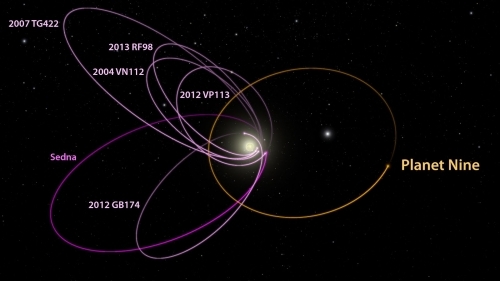
Image credit: Mike Brown/Konstantin Batygin/Caltech.
What’s immediately striking here is that Batygin and Brown could use perturbation theory to see what should happen given the gravitational influence of Jupiter, Saturn, Uranus and Neptune. The orbits in question should become randomly oriented over a timeframe much shorter than the age of the Solar System, which means that we can’t harken back to something that happened billions of years ago. Something must be holding these orbits together now.
Looking back at data from Trujillo and Sheppard, Batygin and Brown could, as Batygin says, see that the long axes of the orbits traced out by these distant objects tended to point in the same direction, providing further evidence of something larger influencing these objects. But add a large planet into this scenario and we should see a set of objects whose orbits are sharply tilted when compared to the plane of planetary orbits. And in fact we do know of six objects that behave exactly like this.
What we need to do now is to find the possible planet and take its picture, because all we have is the inference of a planet based upon orbital anomalies in a small number of outer system objects. But the model that the two researchers have developed combines a number of interesting points about the Kuiper Belt as we know it. Batygin adds:
In the end, our model ties together three elusive aspects of the Kuiper belt (namely, physical alignment of the distant orbits, generation of detached objects such as Sedna and the existence of a population tracing our perpendicular orbital trajectories) into a single, unifying picture. As a dynamical model, this appears compelling. But it is simultaneously important to keep in mind that until Planet Nine is caught on camera, it remains a theoretical prediction.
Until we actually see a new planet, both Batygin and Brown will probably continue to experience what the former calls “an uneasy exhilaration.” Meanwhile, the idea that there may be a planetary discovery of the kind Percival Lowell was looking for — a large world deep in the outer system — awakens an almost atavistic enthusiasm. I’ve always been open to the idea that there must be undiscovered planets in our system, but something ten times the mass of the Earth seemed out of the question. Now we have to find out if, as in the case of Neptune, precise mathematical calculations can indeed lead us to an object we can see.
The Brown and Batygin paper is “Evidence for a Distant Giant Planet in the Solar System,” Astronomical Journal, published online 20 January 2016 (full text). Trujillo & Sheppard’s paper is “A Sedna-like body with a perihelion of 80 astronomical units,” Nature 507 (27 March 2014), pp. 471–474 (abstract).






January 20, 2016
Evidence for 9th Planet Unveiled
A new planet ten times the mass of Earth deep in the outer system? That’s the word out of Caltech, where Konstantin Batygin and Mike Brown report the evidence from computer modeling and simulations, though no planet has yet been directly observed. The planet would orbit 20 times further from the Sun than Neptune, with an orbital period between 10,000 and 20,000 years.
“This would be a real ninth planet,” says Brown. “There have only been two true planets discovered since ancient times, and this would be a third. It’s a pretty substantial chunk of our solar system that’s still out there to be found, which is pretty exciting.”
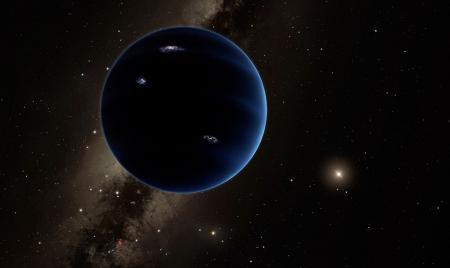
Image: This artistic rendering shows the distant view from Planet Nine back towards the sun. The planet is thought to be gaseous, similar to Uranus and Neptune. Hypothetical lightning lights up the night side. Credit: Caltech/R. Hurt (IPAC).
From what we know so far, the planet would explain features in the Kuiper Belt, including the fact that from a list of thirteen of the most distant objects in the Belt, six of them follow elliptical orbits that point in the same direction in physical space, as this Caltech news release explains. Says Brown:
“It’s almost like having six hands on a clock all moving at different rates, and when you happen to look up, they’re all in exactly the same place,” says Brown. The odds of having that happen are something like 1 in 100, he says. But on top of that, the orbits of the six objects are also all tilted in the same way—pointing about 30 degrees downward in the same direction relative to the plane of the eight known planets. The probability of that happening is about 0.007 percent. “Basically it shouldn’t happen randomly,” Brown says. “So we thought something else must be shaping these orbits.”
A Kuiper Belt with 100 times the mass it has today could explain the phenomenon, but that’s obviously out. Simulations involving a massive planet in an anti-aligned orbit seemed to work, however. By anti-alignment, the researchers mean an orbit in which the planet’s perihelion is 180 degrees across from the perihelion of all other objects and known planets. Mean-motion resonance could keep Kuiper Belt objects from colliding with the planet and maintain the necessary alignment, with the new planet nudging KBOs to maintain the configuration. Says Batygin: “I had never seen anything like this in celestial mechanics.”
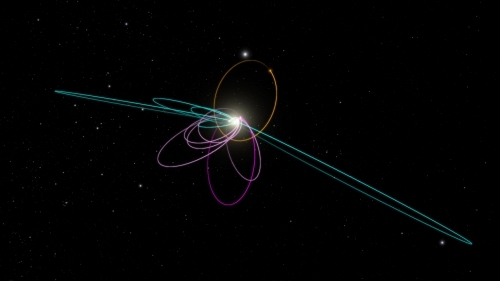
Image: A predicted consequence of Planet Nine is that a second set of confined objects should also exist. These objects are forced into positions at right angles to Planet Nine and into orbits that are perpendicular to the plane of the solar system. Five known objects (blue) fit this prediction precisely. Credit: Caltech/R. Hurt (IPAC) [Diagram was created using WorldWide Telescope.
Brown and Batygin are continuing to refine their simulations to learn more about the planet’s orbit and gravitational effects, while at the same time searching the sky for it. Remember that the orbit is only approximately known. It may well show up in images taken through previous surveys, though if in the most distant part of its orbit, large telescopes like Keck or the Subaru instrument on Mauna Kea may be needed to see it. “I would love to find it,” says Brown. “But I’d also be perfectly happy if someone else found it. That is why we’re publishing this paper. We hope that other people are going to get inspired and start searching.”
The paper, titled “Evidence for a Distant Giant Planet in the Solar System,” appears in the Astronomical Journal, published online 20 January 2016 (full text). Needless to say, more on this tomorrow.






Viewing Pluto Over Time
Knowing that the data from New Horizons continues to arrive gives me a warm feeling about the months ahead. Below we have the highest resolution color image of one of the two potential cryovolcanoes found on the surface during the Pluto flyby last summer. This is Wright Mons, some 150 kilometers across and 4 kilometers high. If this is indeed a volcano, none has been discovered in the outer system that can compare with it in size.
Image credit: NASA/Johns Hopkins University Applied Physics Laboratory/Southwest Research Institute.
The image is a composite drawn from New Horizons’ Long Range Reconnaissance Imager (LORRI) on July 14, 2015. The range is approximately 48,000 kilometers, giving us features down to 450 meters across. JHU/APL has also incorporated color data from the Ralph/Multispectral Visible Imaging Camera (MVIC) taken about 20 minutes after the LORRI images were taken, from a range of 34,000 kilometers, and with a resolution of 650 meters per pixel. The scene on the right is 230 kilometers across.
The question most directly raised by the image is the nature of the sparse red material — why is it where it is and why is it not more widespread? You can also see that this must be a relatively young surface, to judge from the fact that there is only one clear impact crater on Wright Mons. This JHU/APL news release speculates that the young surface is an indication that Wright Mons was active relatively late in Pluto’s history.
So hard to believe it’s been ten years since launch…
10 years ago @NewHorizons2015 had raced past the moon's orbit on its way to Pluto. https://t.co/PgnWuLQfkx #OTD pic.twitter.com/ii7BPxOqtO
— Corey S. Powell (@coreyspowell) January 20, 2016
In 2006, just before the launch, David Grinspoon wrote this in the Los Angeles Times:
Theory alone cannot teach us what there is to know. The universe is stranger and more varied than we can predict or calculate, and that is why we explore. We can’t know exactly what New Horizons will find. But we can safely predict that when we get to Pluto — and the whole new class of worlds it represents — what we discover will baffle, surprise, delight and enlighten.
Pluto As We Used to See It
If you think back to what we knew about Pluto when we could only see it from Earth orbit, it’s heartening to see how much we surmised. As Amanda Zangari (SwRI, and a member of the New Horizons’ Geology, Geophysics and Imaging Team) mentions in a recent blog post, we knew that the surface was covered with nitrogen and methane, and also that tholins were common (Zangari calls them the ‘brown gunk made when UV light hits nitrogen and methane’). And the carbon monoxide patch we saw where Pluto was brightest turned out to be Sputnik Planum, the area forming the left side of Pluto’s now famous ‘heart.’
The New Horizons mission has been an outstanding success, but there is a slight frustration in Zangari’s post having to do with the fact that it was a flyby:
I like to think of the whole experience as getting to look at the answer in the back of the book. To extend the back-of -the-book analogy, like many textbooks, we are only getting half the answer. With Pluto, that missing element isn’t the even problems, but time. Our greatest images are from the July 14 closest encounter, and thus we only have one glimpse of one side of Pluto on one day. Yet these images show Pluto as an active world, undergoing volatile-ice transport and change.
True enough — who wouldn’t want to see an orbiter in this fascinating system? — but have a look at the progress we’ve made. Here I’m directly poaching from Zangari’s post to show the best maps we had before the flyby, made from Hubble Space Telescope images in 2002 and 2003.
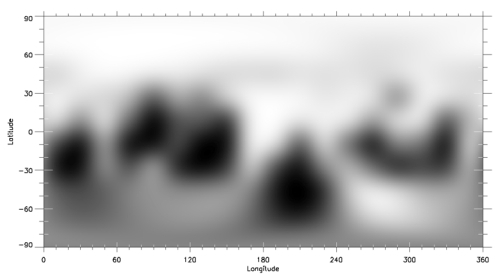
Image credit: NASA/JHUAPL/SwRI/Marc Buie.
And here we are from New Horizons:
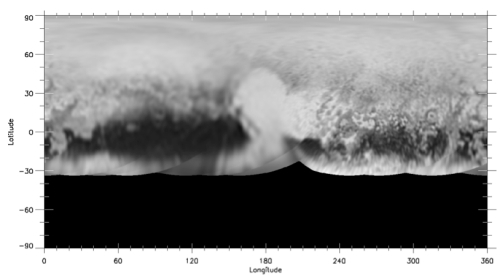
Image credit: NASA/JHUAPL/SwRI.
Zangari tells us that her next project involves comparing measurements of Pluto’s brightness as seen by New Horizons from 2013 to 2015 and comparing these to Hubble Space Telescope observations from 2002 to 2003. The goal: To see how Pluto’s surface has changed over time, a good thing to consider given how surprisingly active the Pluto/Charon system has turned out to be. Sad to think that watching Pluto’s continuing evolution now involves Earth-based telescopes alone. Someday there will be a Pluto orbiter, but none of us can know when.






January 19, 2016
Is Proxima Centauri a Bound Star?
About 1.4 million years from now, the K-class star Gliese 710, now 64 light years distant in the constellation Serpens, will brush past our Solar System. Moving to within 50,000 AU, the star could be expected to have an unsettling effect on cometary orbits in the Oort Cloud, perhaps dislodging some of these comets to cause them to move into our inner planetary system. An interesting scenario, particularly remembering speculation that comets were a source of water for the early Earth, and may perform a similar function in other young systems.
So just how common are such celestial encounters? We may have one at our very doorstep in the form of Proxima Centauri. The Pale Red Dot campaign that began yesterday is focusing on a red dwarf that is roughly 15,000 AU from the close binary stars Centauri A and B. If you think about what our system would look like with a red dwarf at the inner edge of the Oort Cloud, you can see that Proxima may play a large role in the evolution of the triple-star system.
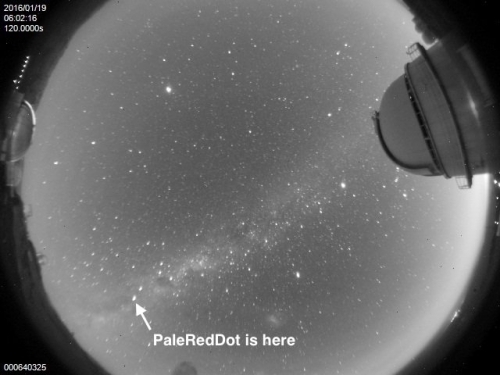
Image: Proxima Centauri, indicated by the arrow, in an image from the first night’s run at the Pale Red Dot observing campaign at La Silla. Credit: ESO/Guillem Anglada-Escudé.
Assuming, that is, that this is a bound system. It was back in 1993 that Robert Matthews and Gerard Gilmore (Cambridge University) studied kinematic data on Proxima and concluded that the star was not necessarily gravitationally bound. In fact, it was on the borderline, and could well be a star that was simply moving past Centauri A and B, having been formed elsewhere. The researchers cited the need for further kinematic data to resolve the matter.
The following year, J. Anosova (Physical Research Laboratory, Ahmedabad, India) proposed that the three Centauri stars were part of a stellar moving group, with Proxima drifting close but not necessarily bound. But the problem would not go away. Proxima’s small relative velocity in relation to Centauri A and B (0.53 ± 0.14 km s-1) makes the likelihood that it is unbound quite small, which is why the assumption of a bound triple system has generally been the rule since the star’s discovery in 1915.
Jeremy Wertheimer and Gregory Laughlin (UC-Santa Cruz) have had the most recent word, finding in 2006 that Proxima is indeed bound to Centauri A and B:
The availability of Hipparcos data has provided us with the ability to implement a significant improvement over previous studies of the α Cen system. Our results indicate that it is quite likely that Proxima Cen is gravitationally bound to the α Cen A-B pair, thus suggesting that they formed together within the same birth aggregate and that the three stars have the same ages and metallicities. As future observations bring increased accuracy to the kinematic measurements, it will likely become more obvious that Proxima Cen is bound to the α Cen A-B binary and that Proxima Cen is currently near the apastron of an eccentric orbit…
The researchers are also able to make a prediction: When we can get a more refined look at Proxima Centauri’s absolute radial velocity, we should see a value of -22.3 km s-1 < vr < -22.0 km s-1. Hence the importance of our continuing investigation of this small star. As we proceed with projects like Pale Red Dot and beyond, we should be able to eventually declare the question of Proxima’s bound status closed.
Ramifications of a Bound Proxima
This is of more than passing interest, because Proxima Centauri could well be influencing the planetary systems (if any) of the two primary Centauri stars. As I mentioned above, a star like Gl 710 passing by our system could cause disruptions in the Oort Cloud, and a passing Proxima Centauri could certainly serve the same function in that system. But a bound Proxima — one that is, as Wertheimer and Laughlin believe, currently located near the apastron position of its orbit, could have useful effects on an infant system. As the paper notes:
If Proxima were bound to the system during its formation stages, then it may have gravitationally stirred the circumbinary planetesimal disk of the α Cen system, thereby increasing the delivery of volatile-rich material to the dry inner regions.
A significant factor indeed as we ponder the question of astrobiology around these stars. Laughlin has written elsewhere about the fact that Alpha Centauri planets will likely be dry because of the close orbit of Centauri A and B — the period of the AB binary pair is 79 years, and the stars make a close approach of 11.2 AU. Silicates and metals condense out of the protoplanetary disks around Centauri A and B, but to get water, we need to go further out, into the circumbinary disk surrounding both stars. A bound Proxima Centauri, then, becomes the mechanism for driving water-laden materials inward to any dry, terrestrial-class planets.
And there is another factor that makes the question of Proxima’s relation to Centauri A and B significant. If Proxima is bound, the implication is that all three stars were formed out of the same molecular cloud, and that would imply not just the same age but the same metallicity (metals being elements higher than hydrogen and helium). We know that both Centauri A and B are richer in metals than our own Sun, and if Proxima is likewise metal-rich, it may have an elevated chance of having planets. The link between gas-giant formation and metals has been well explored, though such a link for rocky worlds is not established.
What all this comes down to is that a gravitationally bound Proxima Centauri would exist as the third member of a system that should be rich in the materials needed to form terrestrial planets. The problem now is to find them using searches like the ongoing effort at La Silla, where the Pale Red Dot campaign will be in progress until April. As mentioned yesterday, you can follow the effort on Twitter: @Pale_red_dot, and use the hashtag #PaleRedDot. Conditions were problematic last night at the observatory but it looks like the first observations were made.
The paper by Matthews and Gilmore is “Is Proxima really in orbit about Alpha CEN A/B?,” Monthly Notices of the Royal Astronomical Society Vol. 261, No. 2 (1993), p. L5-L7 (abstract). The Anosova paper is “Dynamics of nearby multiple stars. The α Centauri system,” Astronomy & Astrophysics 292 (1994), 115-118 (full text). The Wertheimer and Laughlin paper is “Are Proxima and Alpha Centauri Gravitationally Bound?” The Astronomical Journal 132:1995-1997 (2006), available online.






January 18, 2016
Pale Red Dot: Proxima Centauri Campaign Begins
A new observational campaign for Proxima Centauri, coordinated by Guillem Anglada-Escudé (Queen Mary University, London), is about to begin, an effort operating under the name Pale Red Dot. You’ll recall Dr. Anglada-Escudé’s name from his essay Doppler Worlds and M-Dwarf Planets, which ran here in the spring of last year, as well as from Centauri Dreams reports on his work on Gliese 667C, among other exoplanet projects. Pale Red Dot is a unique undertaking that brings the public into an ongoing campaign from the outset, one whose observations at the European Southern Observatory’s La Silla Observatory begin today.
The closest star to our Sun, Proxima Centauri was discovered just over 100 years ago by the Scottish astronomer Robert Innes. A search through the archives here will reveal numerous articles about the red dwarf and the previous attempts to find planets orbiting it. I’ll point you to a round-up of exoplanet work on Proxima thus far next week, when my essay ‘Intensifying the Proxima Centauri Planet Hunt’ will run as part of Pale Red Dot’s outreach campaign. For now, the short summary is that we can rule out various planet scenarios around Proxima, but the possibility of a rocky world in the habitable zone is definitely still in the mix.
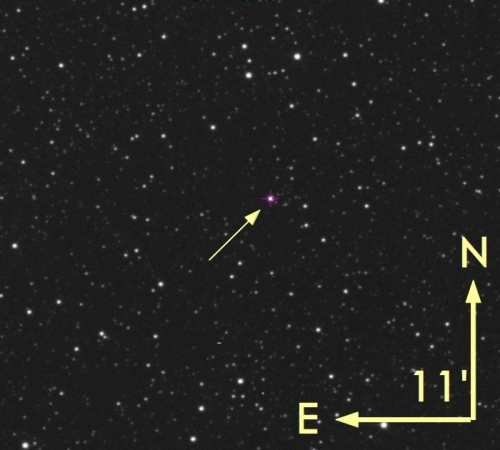
Image: First images of Proxima from the Las Cumbres Observatory Global Telescope Network at Cerro Tololo Inter-American Observatory, Chile.
Pale Red Dot today begins a two and a half month campaign that will run through April using the HARPS spectrograph at ESO’s 3.6-meter telescope at La Silla (Chile). The method here is radial velocity, looking for those infinitesimal Doppler signals showing the star’s motion as affected by planetary companions. These RV studies thus add to the earlier work done by Michael Endl (UT-Austin) and Martin Kürster (Max-Planck-Institut für Astronomie), who studied Proxima using the UVES spectrograph at the Very Large Telescope in Paranal.
But Pale Red Dot’s HARPS data will be complemented by robotic telescopes around the globe, including the Burst Optical Observer and Transient Exploring System (BOOTES) and the Las Cumbres Observatory Global Telescope Network (LCOGT). These automated installations will measure the brightness of Proxima each night during the observing campaign, helping to clarify whether any RV ‘wobbles’ of the star are caused by a planet or by events on the stellar surface. After thorough data analysis, the results will be submitted to a peer-reviewed journal.
The public outreach aspect of Pale Red Dot is compelling. Anglada-Escudé explains:
“We are taking a risk to involve the public before we even know what the observations will be telling us — we cannot analyse the data and draw conclusions in real time. Once we publish the paper summarising the findings it’s entirely possible that we will have to say that we have not been able to find evidence for the presence of an Earth-like exoplanet around Proxima Centauri. But the fact that we can search for such small objects with such extreme precision is simply mind-boggling.
”We want to share the excitement of the search with people and show them how science works behind the scenes, the trial and error process and the continued efforts that are necessary for the discoveries that people normally hear about in the news. By doing so, we hope to encourage more people towards STEM subjects and science in general.”
To communicate the process, Pale Red Dot will use blog posts and social media, with essays from astronomers, scientists, engineers and science writers on the site’s blog. To keep up with the social media updates, use @Pale_red_dot on Twitter for the project account, and you’ll probably want to check the hashtag #PaleRedDot as well. I also want to mention (and this will be in my article next week) that David Kipping’s transit studies of Proxima using the Canadian MOST (Microvariability & Oscillations of STars) space telescope are continuing, and beyond this we have another gravitational microlensing possibility as the star occults a 19.5-magnitude background star this February. Proxima Centauri, 2016 looks to be your year, and perhaps it’s also the year we find out for sure whether there is a planetary system so close to our own.





Paul Gilster's Blog
- Paul Gilster's profile
- 7 followers


